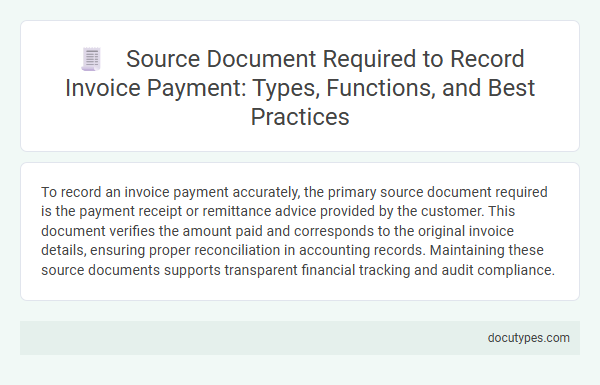To record an invoice payment accurately, the primary source document required is the payment receipt or remittance advice provided by the customer. This document verifies the amount paid and corresponds to the original invoice details, ensuring proper reconciliation in accounting records. Maintaining these source documents supports transparent financial tracking and audit compliance.
Introduction to Invoice Payment Source Documents
What source document is needed to record an invoice payment?
The primary source document required to record an invoice payment is the remittance advice or payment receipt. These documents provide proof of payment and help ensure accurate financial record-keeping for both the payer and the payee.
Types of Source Documents for Invoice Payments
Source documents essential for recording an invoice payment include payment receipts, bank statements, and remittance advices. Payment receipts provide confirmation of the amount paid and the date of the transaction. Bank statements verify the actual transfer of funds, while remittance advices detail the invoice numbers and amounts being settled.
Essential Functions of Source Documents
Source documents are critical for accurately recording invoice payments in your accounting system. These documents provide verifiable evidence to support financial transactions and ensure compliance with accounting standards.
- Verification - Source documents confirm the authenticity and details of the invoice payment.
- Audit Trail - They create a chronological record for internal reviews and external audits.
- Data Accuracy - Source documents help maintain precise financial data by capturing essential transaction information.
Common Examples: Receipts, Vouchers, and Payment Advices
To record an invoice payment accurately, a source document is essential for verifying the transaction. Common examples of these source documents include receipts, vouchers, and payment advices.
Receipts serve as proof of payment received from the customer or client. Vouchers provide authorization for the payment, often detailing the invoice number and payment amount.
Matching Source Documents with Invoices: Why It Matters
Accurately recording an invoice payment requires identifying the correct source document that validates the transaction. Matching source documents with invoices ensures financial records are precise and verifiable.
- Purchase Order - Confirms the buyer's request and agreed terms for goods or services.
- Delivery Receipt - Verifies the receipt of goods as described in the invoice.
- Payment Voucher - Serves as authorization and proof of payment for the invoice amount.
Proper matching of source documents with invoices is essential for audit compliance and maintaining transparent accounting practices.
Compliance and Audit Considerations in Documentation
To record an invoice payment accurately, the primary source document required is the original invoice issued by the supplier. This document provides essential details such as invoice number, payment terms, and amounts due, ensuring proper verification.
Compliance with financial regulations demands maintaining a complete and well-organized invoice payment record, including remittance advice and proof of payment. Auditors rely on these documents to validate transaction authenticity and assess internal controls. Your accounting system should securely store these records to facilitate efficient audits and regulatory reviews.
Best Practices for Source Document Management
| Source Document | Invoice Payment Receipt or Remittance Advice |
|---|---|
| Purpose | Confirms payment has been made against the invoice and details the amount, date, and payment method |
| Key Information to Include | Invoice number, payment date, payer details, amount paid, payment method (e.g., bank transfer, check, credit card), and any discounts or adjustments |
| Best Practices for Source Document Management |
|
| Importance | Reliable source document management enhances financial accuracy, audit readiness, and regulatory compliance |
Digital vs. Paper Source Documents: Pros and Cons
When recording an invoice payment, the choice between digital and paper source documents plays a crucial role in accuracy and efficiency. Your selection impacts how the payment information is stored, retrieved, and verified during audits.
- Digital Source Documents - These allow quick access, easy storage, and automated integration with accounting software, reducing human error.
- Paper Source Documents - Physical invoices provide tangible proof of payment but are susceptible to loss, damage, and require manual handling.
- Verification and Compliance - Both formats must comply with legal and regulatory requirements, but digital documents often include metadata that enhances traceability and security.
Challenges in Recording Invoice Payments Accurately
Recording an invoice payment requires the original invoice as the primary source document. This document provides essential details such as the invoice number, payment amount, and due date, ensuring accurate tracking of transactions.
Challenges in recording invoice payments accurately include mismatched payment amounts and incomplete documentation. You must verify these details carefully to avoid errors and maintain reliable financial records.
What Source Document Is Needed to Record an Invoice Payment? Infographic

